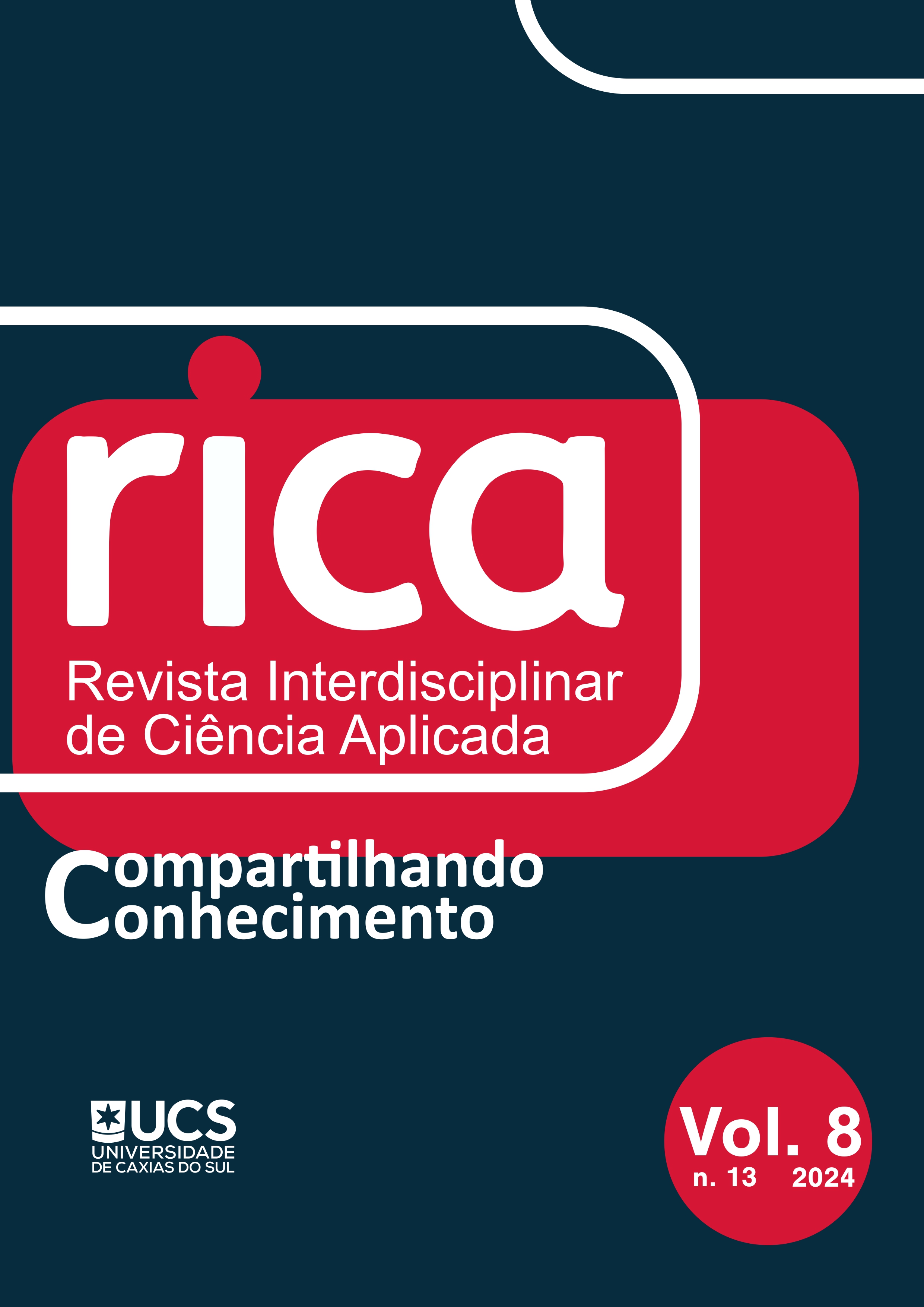Pesquisa sobre o impacto da inteligência artificial na segurança financeira no contexto dos desafios tecnológicos modernos
DOI:
https://doi.org/10.18226/25253824.v8.n13.08Palavras-chave:
Inovação, Tendências globais, Aprendizado de máquina, Riscos, Segurança da informação, PreconceitosResumo
A natureza ambígua das consequências da introdução da inteligência artificial exige a investigação de seus benefícios e riscos no contexto da segurança financeira. O objetivo deste estudo foi avaliar as perspectivas e os riscos existentes da introdução da inteligência artificial na área da segurança financeira de empresas e instituições e desenvolver mecanismos para mitigar os problemas identificados. O estudo empregou o método estatístico, o método preditivo, o método descritivo, os métodos de análise e síntese e o método qualitativo. O estudo identificou as principais áreas promissoras para a introdução da inteligência artificial, incluindo a detecção de anomalias, a melhoria dos procedimentos de pagamento, a autenticação de documentos, a minimização de erros e o aconselhamento sobre a tomada das melhores decisões de investimento. As principais desvantagens identificadas incluíram riscos à segurança da informação e de dados pessoais, o risco de viés, injustiça e discriminação, o deslocamento de empregos e a perda de habilidades profissionais das pessoas. Mas são particularmente preocupantes as consequências globais de longo prazo do impacto da inteligência artificial na sociedade como um todo e as dúvidas sobre a capacidade de controlá-la. Para mitigar os riscos identificados, o estudo propôs a utilização da ferramenta Senior Managers and Certification Regime (SM&CR), que permite responsabilizar os funcionários por seu comportamento e competência. Também foi enfatizada a necessidade de a gestão da empresa estar plenamente ciente de todos os aspectos da implementação da inteligência artificial, incluindo seu tipo, riscos associados, oportunidades e impacto sobre todas as partes interessadas. Os resultados deste estudo podem ser úteis na prática de empresas e instituições que planejam implementar inteligência artificial para aumentar a conscientização sobre os benefícios, riscos e sua minimização.
Referências
Ntoutsi, E., Fafalios, P., Gadiraju, U., Iosifidis, V., Nejdl, W., Vidal, M., Ruggieri, S., Turini, F., Papadopoulos, S., Krasanakis, E., Kompatsiaris, I., Kinder‐Kurlanda, K., Wagner, C., Karimi, F., Fernandez, M., Alani, H., Berendt, B., Kruegel, T., Heinze, C., Broelemann, K., Kasneci, G., Tiropanis, T. & Staab, S. (2020). Bias in data‐driven artificial intelligence systems – An introductory survey. WIREs Data Mining and Knowledge Discovery, 10(3), e1356.
Safdar, N.M., Banja, J.D. & Meltzer, C.C. (2020). Ethical considerations in artificial intelligence. European Journal of Radiology, 122, 108768.
Joyce, K., Smith-Doerr, L., Alegria, S., Bell, S., Cruz, T., Hoffman, S.G., Noble, S.U. & Shestakofsky, B. (2021). Toward a sociology of Artificial Intelligence: A call for research on inequalities and structural change. Socius, 7, 1-11.
Cao, L. (2022). AI in finance: Challenges, techniques, and opportunities. ACM Computing Surveys, 55(3), 64.
Turchin, A. & Denkenberger, D. (2020). Classification of global catastrophic risks connected with artificial intelligence. AI & Society, 35(1), 147-163.
McLean, S., Read, G.J., Thompson, J., Baber, C., Stanton, N.A. & Salmon, P.M. (2021). The risks associated with artificial general intelligence: A systematic review. Journal of Experimental & Theoretical Artificial Intelligence, 35(5), 649-663.
Azarbekov, A.N. (2023). The concept of political power in the conditions of modernity. Proceedings of the National Academy of Sciences of the Kyrgyz Republic, 5, 26-30.
Sayakbayeva, A.A., Akylbekova, N.I. & Taalaibek, T. (2020). Digitalization as a platform for online business development in the banking sector of the Kyrgyz Republic. Actual Issues of Modern Economy, 9, 394-404.
Abdrasulova, Z. & Abdrasulova, S. (2022). Digitalization of the banking sector of the economy: Problems and ways of improvement. Journal of Osh State University. Economics, 1(1), 154-163.
Seitova, Z. & Tynych kyzy, N. (2022). Traditional and modern approaches to risk management in banks. Journal of Osh State University. Economics, 1(1), 171-178.
Khubieva, S. & Yugai, N. (2021). Main directions of development of digitalisation of public services in the Kyrgyz Republic in modern conditions. BSU Bulletin, 1(55), 156-159.
Azimov, Zh.M. & Ismailova, N.R. (2020). Development of Kyrgyzstan’s investment market in the context of digitalisation. Actual Issues of Modern Economy, 4, 685-695.
Global Artificial Intelligence market by solution (hardware, software, and services), by technology (deep learning, machine learning, NLP), by end-use (manufacturing, healthcare, law, BFSI, advertising & media, retail, agriculture, automotive & transportation, other end-uses), by region and key companies – Industry segment outlook, market assessment, competition scenario, trends and forecast 2023-2032. (2024). Retrieved from https://market.us/report/artificial-intelligence-market/#overview
Generative AI in financial services market revenue to be USD 9,475.2 Mn in 2032 | North America dominates with 40% of the market share. (2023). Retrieved from https://www.globenewswire.com/news-release/2023/06/12/2686443/0/en/Generative-AI-in-Financial-Services-Market-Revenue-To-Be-USD-9-475-2-Mn-in-2032-North-America-Dominates-with-40-of-the-Market-Share.html
World Economic Forum. (2023). Future of jobs report 2023: Insight report. Retrieved from https://www3.weforum.org/docs/WEF_Future_of_Jobs_2023.pdf
DP5/22 – Artificial Intelligence and Machine Learning. (2022). Retrieved from https://www.bankofengland.co.uk/prudential-regulation/publication/2022/october/artificial-intelligence
FS2/23 – Artificial Intelligence and Machine Learning. (2023). Retrieved from https://www.bankofengland.co.uk/prudential-regulation/publication/2023/october/artificial-intelligence-and-machine-learning
Helm, J.M., Swiergosz, A.M., Haeberle, H.S., Karnuta, J.M., Schaffer, J.L., Krebs, V.E., Spitzer, A.I. & Ramkumar, P.N. (2020). Machine learning and artificial intelligence: Definitions, applications, and future directions. Current Reviews in Musculoskeletal Medicine, 13(1), 69-76.
Trenker, J., Satkriti Menon, S., Tavva, N. & Blumtritt, C. (2023). If Big Data is the new oil, AI is the new electricity. Retrieved from https://www.statista.com/site/insights-compass-ai-ai-market-overview
Makarchuk, I., Malyshko, V. & Yaremenko, L. (2023). Financial security of enterprises: Characteristics, components, main threats and dangers. University Economic Bulletin, 56, 183-193.
Pratt, K. (2023). UK artificial intelligence (AI) statistics and trends in 2024. Retrieved from https://www.forbes.com/uk/advisor/business/software/uk-artificial-intelligence-ai-statistics-2023/
Nechyporenko, A. (2023). Features of financial risk management of the enterprise in the conditions of transformational changes. University Economic Bulletin, 56, 200-206.
Truby, J. (2020). Governing artificial intelligence to benefit the UN Sustainable Development Goals. Sustainable Development, 28(4), 946-959.
Galaz, V., Centeno, M.A., Callahan, P.W., Causevic, A., Patterson, T., Brass, I., Baum, S., Farber, D., Fischer, J., Garcia, D., McPhearson, T., Jimenez, D., King, B., Larcey, P. & Levy, K. (2021). Artificial intelligence, systemic risks, and sustainability. Technology in Society, 67, 101741.
Shanmuganathan, M. (2020). Behavioural finance in an era of artificial intelligence: Longitudinal case study of robo-advisors in investment decisions. Journal of Behavioral and Experimental Finance, 27, 100297.
Dowling, M. & Lucey, B. (2023). ChatGPT for (finance) research: The Bananarama conjecture. Finance Research Letters, 53, 103662.
Mhlanga, D. (2020). Industry 4.0 in finance: The impact of artificial intelligence (AI) on digital financial inclusion. International Journal of Financial Studies, 8(3), 45.
Bao, Y., Hilary, G. & Ke, B. (2022). Artificial intelligence and fraud detection. In: Innovative Technology at the Interface of Finance and Operations (pp. 223-247). Cham: Springer.
Al-Hashedi, K.G. & Magalingam, P. (2021). Financial fraud detection applying data mining techniques: A comprehensive review from 2009 to 2019. Computer Science Review, 40, 100402.
Ashta, A. & Herrmann, H. (2021). Artificial intelligence and fintech: An overview of opportunities and risks for banking, investments, and microfinance. Strategic Change, 30(3), 211-222.
El Hajj, M. & Hammoud, J. (2023). Unveiling the influence of artificial intelligence and machine learning on financial markets: A comprehensive analysis of AI applications in trading, risk management, and financial operations. Journal of Risk and Financial Management, 16(10), 434.
Krause, D. (2023). Adapting the finance curriculum for an AI-driven future. Retrieved from https://dx.doi.org/10.2139/ssrn.4448143
Dwivedi, Y.K., Hughes, L., Ismagilova, E., Aarts, G., Coombs, C., Crick, T., Duan, Y., Dwivedi, R., Edwards, J., Eirug, A., Galanos, V., Ilavarasan, P.V., Janssen, M., Jones, P., Kar, A.K., Kizgin, H., Kronemann, B., Lal, B., Lucini, B., Medaglia, R. & Williams, M.D. (2021). Artificial intelligence (AI): Multidisciplinary perspectives on emerging challenges, opportunities, and agenda for research, practice and policy. International Journal of Information Management, 57, 101994.
Königstorfer, F. & Thalmann, S. (2020). Applications of artificial intelligence in commercial banks – A research agenda for behavioral finance. Journal of Behavioral and Experimental Finance, 27, 100352.
Mhlanga, D. (2021). Financial inclusion in emerging economies: The application of machine learning and artificial intelligence in credit risk assessment. International Journal of Financial Studies, 9(3), 39.
Melnychenko, O. (2020). Is artificial intelligence ready to assess an enterprise’s financial security? Journal of Risk and Financial Management, 13(9), 191.
Downloads
Publicado
Como Citar
Edição
Seção
Licença
Copyright (c) 2024 Gashi et al.

Este trabalho está licenciado sob uma licença Creative Commons Attribution 4.0 International License. Autores mantém os direitos autorais e concedem à revista o direito de primeira publicação, com o trabalho simultaneamente licenciado sob a Creative Commons Attribution License que permitindo o compartilhamento do trabalho com reconhecimento da autoria do trabalho e publicação inicial nesta revista.






